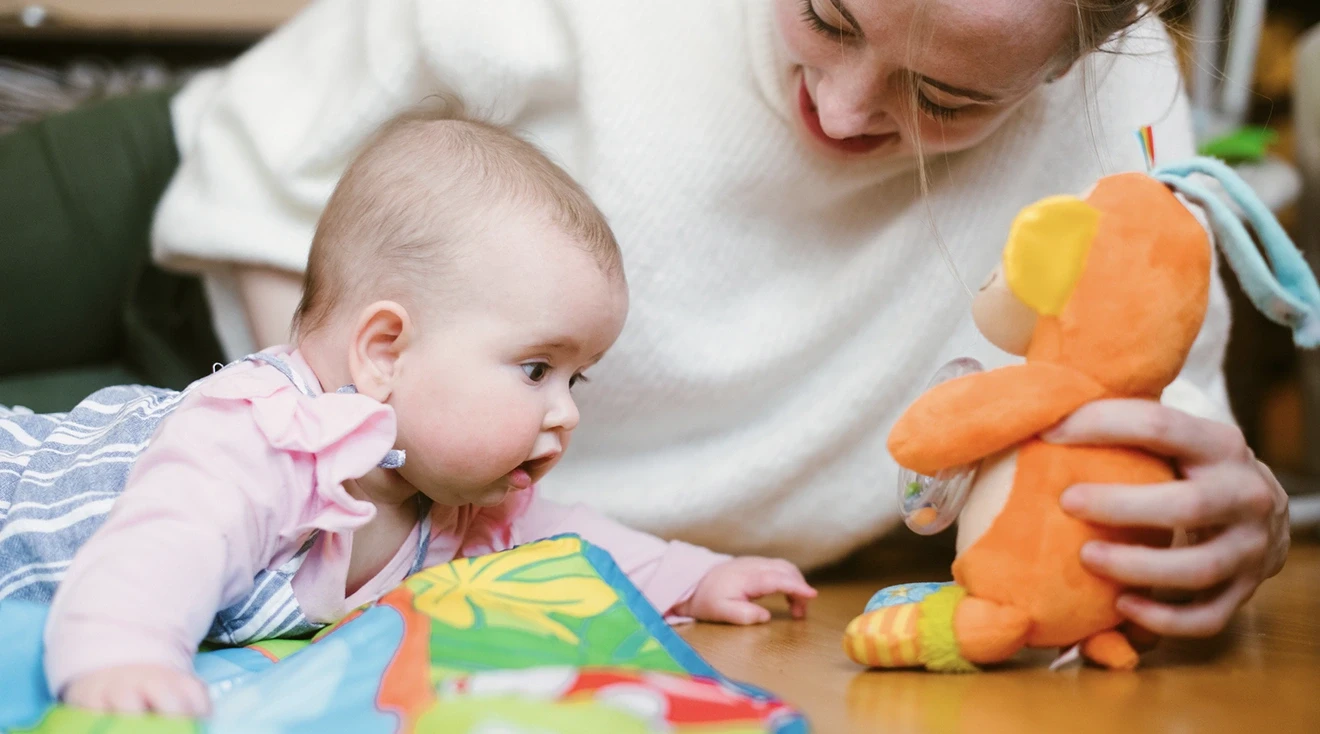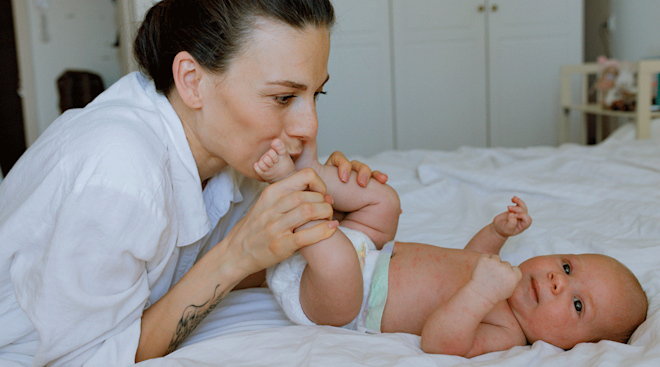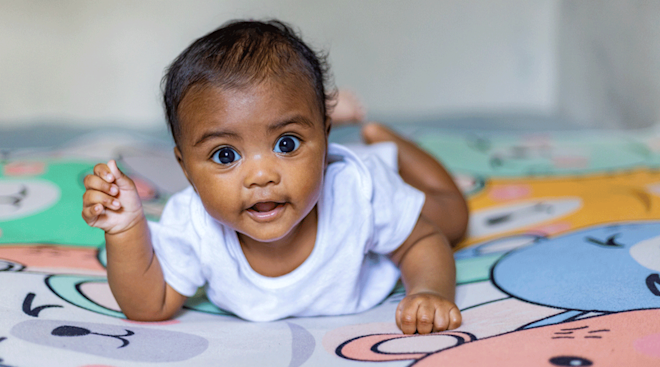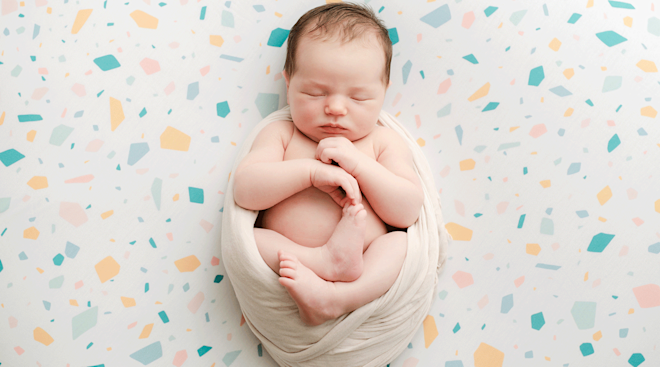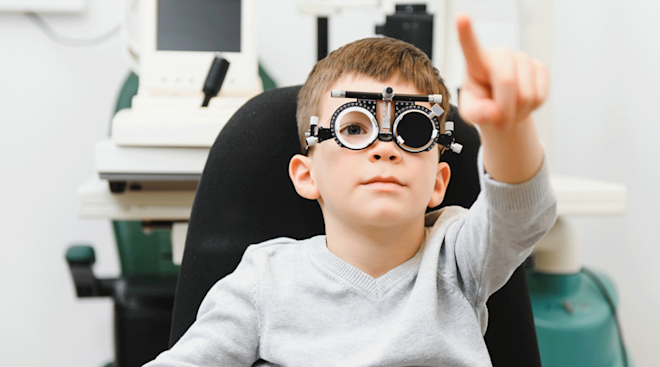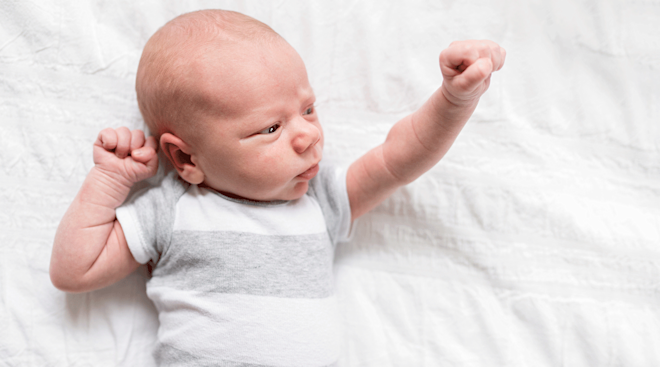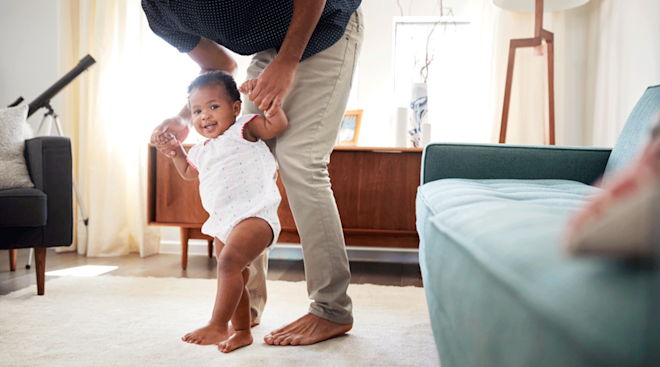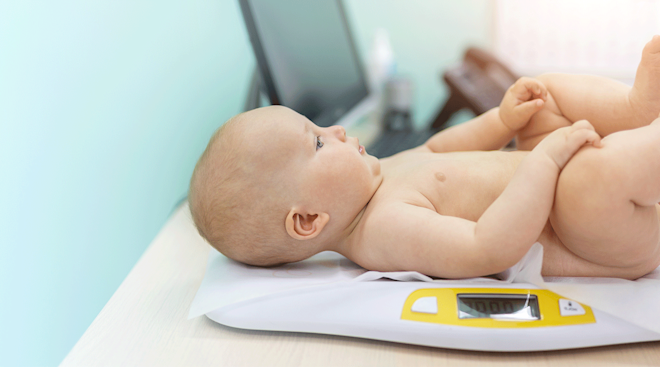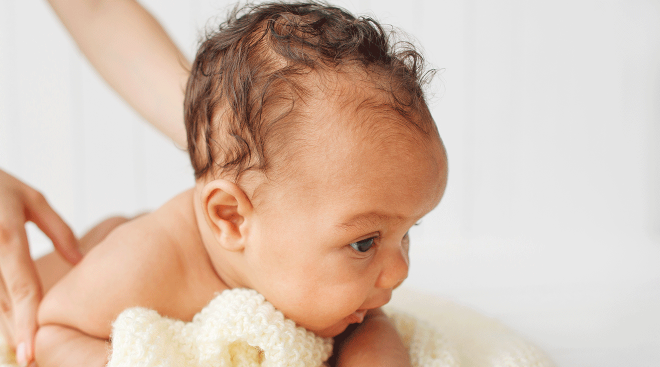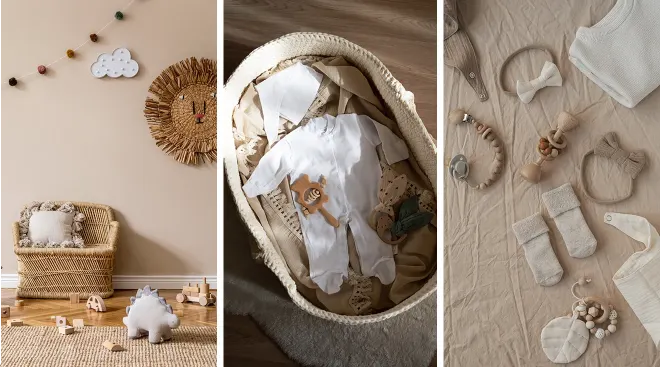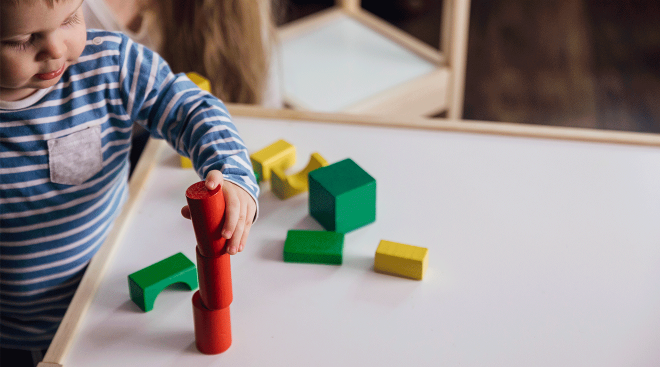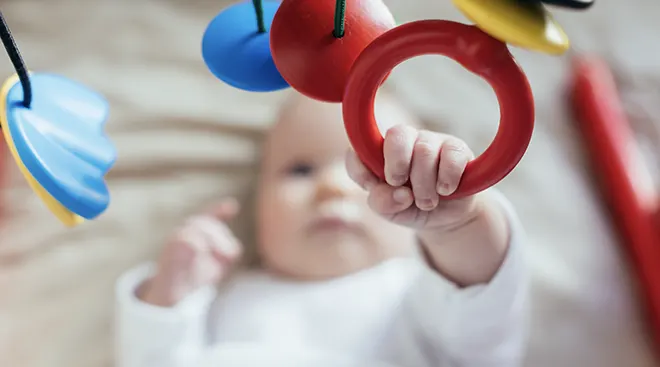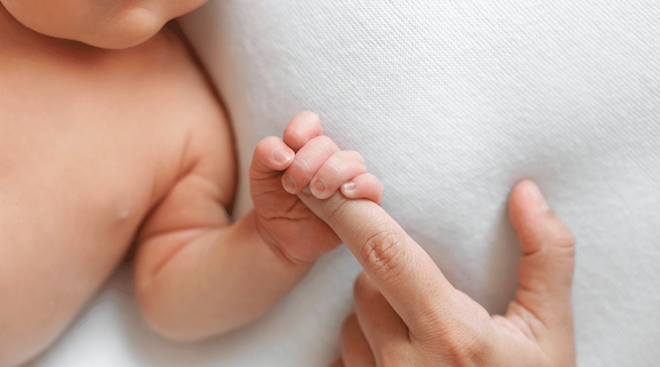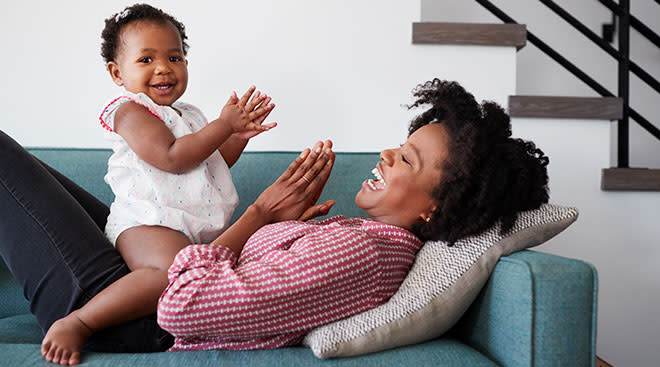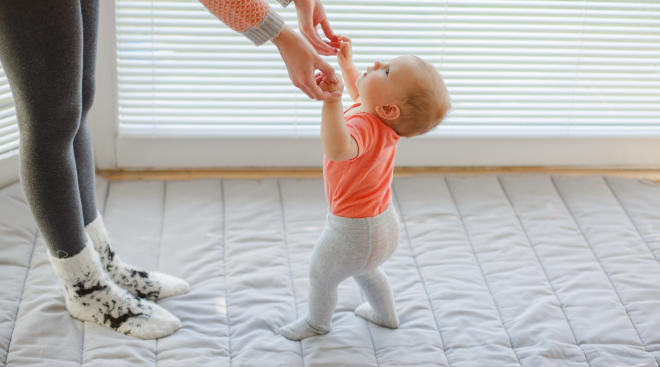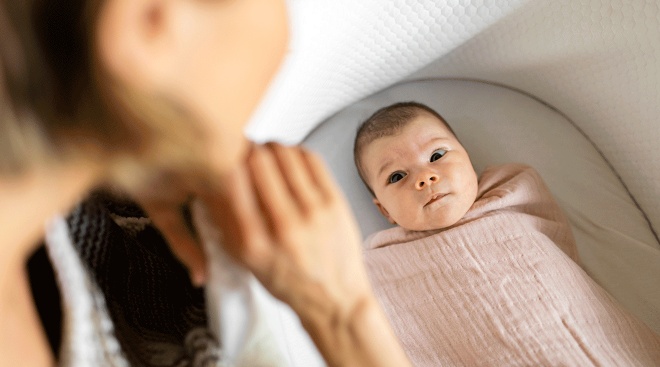What Are Gross and Fine Motor Skills?
Sure, those in utero kicks and elbow jabs feel intense during pregnancy—but it’s not until your little one leaves the womb that they really begin making strides in their strength, movement and motor skills. Infants learn by exploring the world around them; the more they move, the more their cognitive and social skills progress. But how do newborns go from helpless blobs to moving, grooving tiny people—and how can you encourage their progress and development? It mostly comes down to time and practice. Here’s what you need to know about gross and fine motor skill development, and how you can support baby every step of the way.
Whether your infant is rolling over or reaching for a toy, everything they do involves motor skills, or specific movements performed to accomplish a particular task. The skills baby begins to develop in infancy eventually enable them to bend, twist, jump, hop, skip, kick, catch, throw, play and self-feed—all in due time, of course.
Fine vs. gross motor skills
Motor skills are broken down into two main categories: gross motor skills and fine motor skills. Gross motor skills involve the body’s largest muscles, while fine motor skills involve smaller muscles and, oftentimes, more refined, coordinated movements.
“Gross motor skills involve whole body movement, like rolling over, walking, climbing and jumping,” explains Joanna Tsopelas, MD, fellow of the American Academy of Pediatrics and assistant director of general pediatrics at Maimonides Children’s Hospital in New York. Fine motor skills, on the other hand, call on smaller muscles of the hands for activities, such as stacking blocks and picking up Cheerios. Gross motor stability is a precursor to developing fine motor skills, says Caroline Martinez, MD, a developmental pediatrician at Mount Sinai Kravis Children’s Hospital in New York. But both are required for baby to operate independently down the road.
Mastering gross motor skills requires the ability to control large muscles of the body, such as legs, body and arms, says Martinez. Examples of gross motor skills include crawling, cruising and, eventually, walking. Suffice it to say that babies in motion have gross motor skills to credit.
During wellness visits, your pediatrician will ask about baby’s developmental milestones, with the expectation that skills surface in a predictable pattern. That said, different babies achieve developmental milestones at different times, not at definitive ages, notes Tsopelas. “Some do things faster, and some lag, but it’s not always because they’re delayed,” she adds.
All of this is to say that baby will likely achieve the gross motor skills below around the ages listed below. And if they don’t? “All developmental milestones need to be considered in the context of a child’s medical and neurological history,” says Carl E. Stafstrom, MD, director of the division of pediatric neurology at Johns Hopkins University in Baltimore. “There’s a range of normal.”
Here are the gross motor skills to look out for, according to our experts and the Centers for Disease Control and Prevention (CDC).
Gross motor skills for 2-month-olds
Holding head up 45 degrees when on tummy Moving both arms and both legs Opening hands briefly
Activities to support gross motor skill development:.
- Lay baby on their tummy when they’re awake, and put toys at eye level in front of them
Gross motor skills for 4-month-olds
- Holding head steady without support when being held
- Holding head up 90 degrees while on tummy
- Pushing up onto elbows or forearms when on tummy
- Rolling from belly to back
Activities to support gross motor skill development:
- Provide safe opportunities for play (i.e. on a play mat with toys just out of reach); let baby reach, kick and explore their environment
- Place baby on their back and hold a colorful toy at eye level, moving it back and forth
Gross motor skills for 6-month-olds
- Rolling from back to tummy (and tummy to back)
- Pushing up with straight arms from tummy
- Sitting alone briefly
Activities to support gross motor skill development:
- Encourage rolling by putting baby on their tummy or back and placing toys just out of reach
- Offer toys for baby to look at while supporting them in a sitting position
- Hold baby upright with both of your hands, so they can get a feel for a standing position
Gross motor skills for 9-month-olds
- Standing with support
- Sitting without support
- Possibly crawling or rocking on their hands and knees
Activities to support gross motor skill development:
- Provide safe opportunities for tummy time
- Prop baby up with pillows in a seated position, or place toys just out of reach or on a low table to encourage them to scoot or stand up to reach them
- Avoid walkers, which can be unsafe and encourage an incorrect and potentially dangerous gait
Gross motor skills for one-year-old
- Pulling to stand
- Walking while holding furniture or walking a few steps independently
- Possibly crawling
Activities to support gross motor skill development:
- Place toys just beyond baby’s reach on the floor to encourage them to scoot, crawl or roll
Gross motor skills for 15-month-olds
- Walking or taking steps independently
- Trying to dance
- Stooping and recovering
Activities to support gross motor skill development:
- Ensure your home is safe to explore by moving sharp and breakable objects out of reach
Gross motor skills for 18-month-olds
- Walking without holding anyone or anything
- Climbing on and off a couch or chair without help
Activities to support gross motor skill development:
- Provide toys that your child can push safely, like a doll stroller
Gross motor skills for 2-year-olds
- Kicking a ball
- Walking up a few stairs with or without assistance
Activities to support gross motor skill development:
- Let your kid play with a ball, encouraging them to kick and roll
Gross motor skills for 2-year-olds
- Running
- Walking up stairs
- Jumping
Activities to support gross motor skill development:
- Bring them to different environments, like the playground, where there are objects to climb up, jump on and crawl through
Gross motor skills for 3-year-olds
- Running
- Kicking a ball
- Climbing stairs or walking up them one foot at a time
- Balancing on one foot
Activities to support gross motor skill development:
- Play with your child outside in the backyard or park
- Provide pedaled riding toys
Fine motor skills involve the coordination of the small muscles of the hands, mouth and feet, says Martinez. Most developmental milestones in this department involve activities that can be done with the hands and fingers; some fine motor skills examples include eating with a spoon or stacking blocks.
Remember, these are ballpark ages; healthy babies may reach different milestones early or late without cause for concern. Generally speaking, these are the milestones you can expect baby to achieve—give or take a month or two.
Fine motor skills for 2-month-olds
- Opening and closing fists
- Holding objects briefly
- Following objects with eyes
Activities to support fine motor skill development:
- Sing songs that describe actions and hand motions
Fine motor skills for 4-month-olds
- Reaching for toys
- Transferring toys from one hand to the other
- Following objects with head and eyes
- Holding a toy when you put it in baby’s hand
- Using their arm to swing at toys
- Bringing hands to their mouth
Activities to support fine motor skill development:
- Place objects directly in baby’s hand to explore, then place it just out of reach so they have to activate more muscles to grasp them
Fine motor skills for 6-month-olds
- Bringing objects to their mouth
- Transferring objects from hand to hand
- Banging objects together
- Shaking a rattle
Activities to support fine motor skill development:
- Provide safe toys that baby can hold in their hand and shake to make noise
Fine motor skills for 9-month-olds
- Moving things from one hand to the other hand
- Using fingers to “rake” food towards themselves
- Banging two things together
- Grasping with thumb and fingers
Activities to support fine motor skill development:
- Pass a toy to your baby, then take it back
Fine motor skills for one-year-olds
- Releasing objects into a container
- Turning pages of a book and pointing to the pictures
- Feeding themselves with their hands
- Building towers with blocks
- Using pincer grasp (forefinger and thumb)
Activities to support fine motor skill development:
- Provide stacking toys; shape sorters; open-and-close toys, like a box with a lid and a variety of other toys baby can manipulate with their hands
Fine motor skills for 15-month-olds
- Drinking from a cup without a lid with help
- Picking things up between thumb and pointer finger
- Scribbling
- Stacking two blocks
Activities to support fine motor skill development:
- Let baby feed themselves safe finger foods
- Read books—especially those with flaps—to baby; allow them to explore the pictures
Fine motor skills for 18-month-olds
- Building tower
- Scribbling and beginner drawing
- Using utensils
Activities to support fine motor skill development:
- Provide baby with wooden blocks and stacking toys
Fine motor skills for 2-year-olds
- Holding cup with one hand
- Eating with a spoon
- Drawing vertical and horizontal lines
Activities to support fine motor skill development:
- Provide crayons and paper, and let them create masterpieces
- Allow opportunities for self-feeding with safe foods
Fine motor skills for 3-year-olds
- Stringing beads together
- Putting some clothes on independently
- Using a fork
- Using hands to turn doorknobs or unscrew lids
- Drawing a circle
Activities to support fine motor skill development:
- Let your child help at mealtime. Give them simple jobs, such as washing fruits and vegetables or stirring
- Provide paper, crayons and coloring books, and encourage artistic expression
Motor delays can be linked to prematurity, genetics, or another medical condition. Other reasons include lack of stimulation or tummy time, which is vital for developing the neck and core strength needed to lift the head and roll. Often the cause of a delay is unknown. The key isn’t figuring out why it’s happening, but screening to identify delays and referring to services so a child can catch up and reach their maximum potential.
Because gross and visual motor delays could compromise fine motor skill development, it’s important to identify them as early as possible for intervention. Your pediatrician will screen baby during wellness appointments. Be proactive, and ask your pediatrician what skills your baby should be acquiring before their next doctor’s visit, then monitor independently, suggests Tsopelas.
Remember, a premature infant’s developmental milestones most likely won’t align with all guidelines. “Parents of premature infants should remember their child isn’t the same as a full-term child who is the same age,” Tsoelas says. For instance, when a baby born at 30 weeks is 4 months old, they should only be expected to reach milestones of a 2-month-old. Tsopelas says they should catch up by the time they are 2 years old, as long as there are no neurological injuries or deficits.
If you’re concerned about baby’s development at any time, talk to your pediatrician. They can refer your child for a comprehensive evaluation and treatment by a developmental pediatrician and/or early intervention, a state and federally funded program that addresses developmental issues to prevent further delays.
Signs of a motor skills delay
Developmental milestones are designed to provide parents and pediatricians with a rough guideline so they can monitor progress over time and flag plateaus and regressions, explains Stafstrom. That said, “babies may lag behind by about 3 months. Remember, it’s a range, not an absolute,” Tsopelas reiterates. “There can be a bit more of a lag with fine motor skills since they take more coordination.”
Milestones that are missed by more than a few months could indicate a delay and cause for early intervention. Below, some potential signs of a motor skill delay:
Gross motor skill delays:
- Not holding head with control in a supported sitting position by 6 months
- Not rolling by 7 months
- Not sitting independently by 9 months
- Not pulling to stand by 12 months
- Not walking by 18 months
- Not jumping by 30 months
Fine motor skill delays:
- Not tracking objects by 3 months
- Frequently in a fisted position with both hands after 6 months
- Not reaching for objects by 6 months
- Not bringing hands to midline (center of face) by 4 months
- Not banging objects together by 10 months
All babies develop on their own timeline, so try not to stress. Keep in mind that anything you do to engage with your child can be considered a developmental tool, says Tsopelas. Playing together will help them learn and grow, while giving you the opportunity to monitor their progress.
Please note: The Bump and the materials and information it contains are not intended to, and do not constitute, medical or other health advice or diagnosis and should not be used as such. You should always consult with a qualified physician or health professional about your specific circumstances.
Plus, more from The Bump:
Caroline Martinez, MD, is a developmental pediatrician at Mount Sinai Kravis Children’s Hospital in New York. She earned her medical degree from the State University of New York Downstate Medical Center.
Joanna Tsopelas, MD, is a fellow of the American Academy of Pediatrics and assistant director of general pediatrics at Maimonides Children’s Hospital in New York. She earned her medical degree from St. George’s University in New York.
Carl E. Stafstrom, MD, is the director of the division of pediatric neurology at Johns Hopkins University in Baltimore. He earned his doctor of philosophy and medical degree from the University of Washington School of Medicine.
Centers for Disease Control and Prevention (CDC), Important Milestones: Your Baby by 2 Months
Learn how we ensure the accuracy of our content through our editorial and medical review process.
Navigate forward to interact with the calendar and select a date. Press the question mark key to get the keyboard shortcuts for changing dates.

































